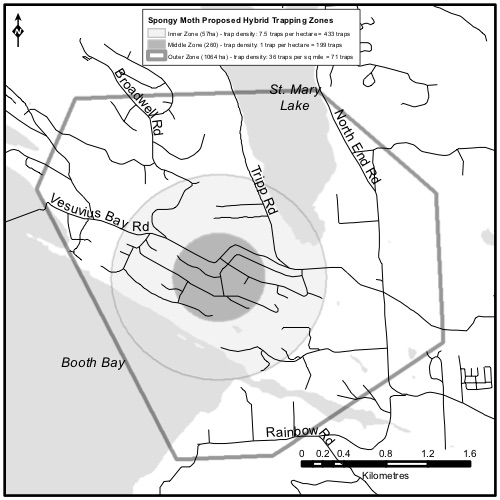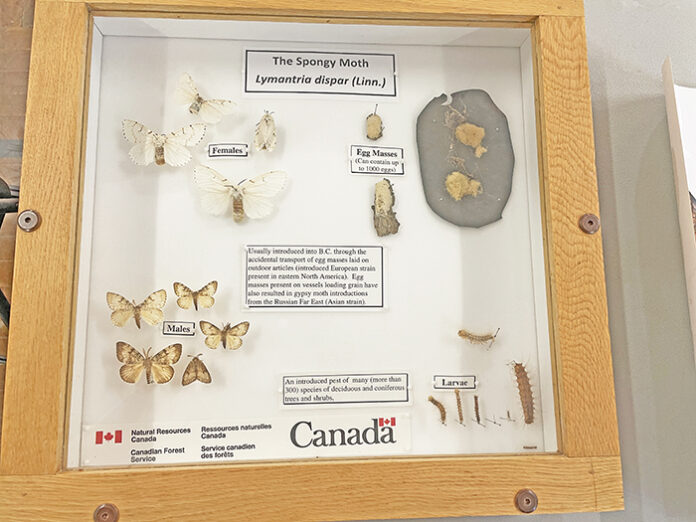Some Salt Spring Island trees are sporting a new shade of green this summer as a spongy moth trapping program shifts into high gear.
More than 700 bright-green tent-shaped traps have been set out in three different zones around Vesuvius and St. Mary Lake where the moth population grew significantly between 2021 and 2022. Some pheromone-laced traps, which attract the male moths, are always set out by the Canadian Food Inspection Agency (CFIA), but the rise in trapped moth numbers last year prompted a major response for 2023. European spongy moth caterpillars (or Lymantria dispar, formerly known as gypsy moths) are voracious defoliators of numerous tree and shrub species.

Brian Van Hezewijk, a research scientist with the Canadian Forest Service in Victoria, detailed the Salt Spring-specific increase to about a dozen people attending a recent open house event at Fulford Hall.
“It went from three moths in one trap two years ago to 13 moths in six traps [in the Vesuvius area],” said Van Hezewijk. “That tells us that it’s now well on its way to increasing . . . I wouldn’t be surprised if we saw 100 moths in our traps this year. What we’re hoping is that it’s in a concentrated area — or zero. That would be great, but I’m not betting on it.”
Three male moths were also trapped in other areas closer to Ganges last year, for a total of 16.
“Those numbers might seem low,” said Babita Bains, chair of the province’s Spongy Moth Technical Advisory Committee, “but they are quite significant for a species that we eradicate for.”
Province wide, 356 male spongy moths were trapped in 2022, which Bains said is “huge” compared to the more usual 20 or 50 she has seen in the previous six years in her role.
“I was away for a year and when I came back and saw 356, I almost fainted. I thought that was a typo, but that is correct.”
Intense trapping is a basic part of an eradication strategy, the meeting heard.
“Every male that you take out of the population means that there’s another unmated female out there that’s not going to produce viable eggs,” said Van Hezewijk. “And that means 500 or 1,000 caterpillars that we have fewer of next year.”
But just as important is the information about the moths’ whereabouts that trapping provides, so egg mass searches and perhaps spraying with the biological insecticide Bacillus thuringiensis kurstaki (Btk) can be more focused.
“That’s what we want to know — where those reproducing females are. So the more information we have about egg masses and caterpillars the better,” said Van Hezewijk.
He and others working to keep the moth from establishing itself in B.C. are urging people to be on the lookout for the flat, sponge-like egg masses on their property, or the moths and caterpillars themselves. (Online searches provide images.) Because the male moths have few distinct markings they are not easy to identify. Caterpillars are distinguished by their four sets of two blue dots and six sets of red dots on their body.
Egg masses are usually placed in protected spots. While they may be found in the crook where a branch comes off a tree, the moths actually prefer human-made objects, such as vehicles, boats or garden-related paraphernalia, as host sites.
Nick Wong of the Invasive Species Council of B.C. (ISCBC) said “cars and RVs seem to be the preferred spot,” while also giving the tray of a flower planter as another typical example during his presentation at the June 7 meeting.
Wong said the recent rise in B.C. spongy moth numbers can be attributed to egg masses attached to the undercarriage or wheel wells of vehicles travelling from Ontario, which has experienced a huge infestation in some areas. A couple of former Ontario residents at the meeting attested to the devastation caused by the spongy moth caterpillar and the challenges of trying to control it, which falls to private property owners in that province.
Any sightings of eggs, moths or caterpillars should be reported to the ISCBC at bcinvasives.ca/take-action/report/ or the CFIA at 250-363-3618. Take digital photos, if possible.
“Once they’re here, the females themselves don’t fly,” said Wong, noting that their bodies are too laden with eggs for flight, “but the small larvae can balloon on the winds” and spread for about a kilometre by that method.
Bains addressed the issue of Btk spraying, as she said it would inevitably be used on Salt Spring if the trapped moth numbers do not drop significantly. Btk was applied from the ground on an area near Lee’s Hill back in 2007, along with intense trapping and egg mass searching.
She said that even though people seem to think ground spraying is better, “they actually use a way higher concentration of the product. And they’re way more invasive because you have people in your yard, it stinks. So your exposure to the product is a lot higher than if it’s aerial spraying.”
Some audience members said they were concerned that aerial spraying would kill other moth/caterpillar species, which was acknowledged to be the case.
Van Hesilijk said spray application is now very precise and controlled by a GPS system. However, he added, if the infested area is small enough, ground spray may be a feasible option.

